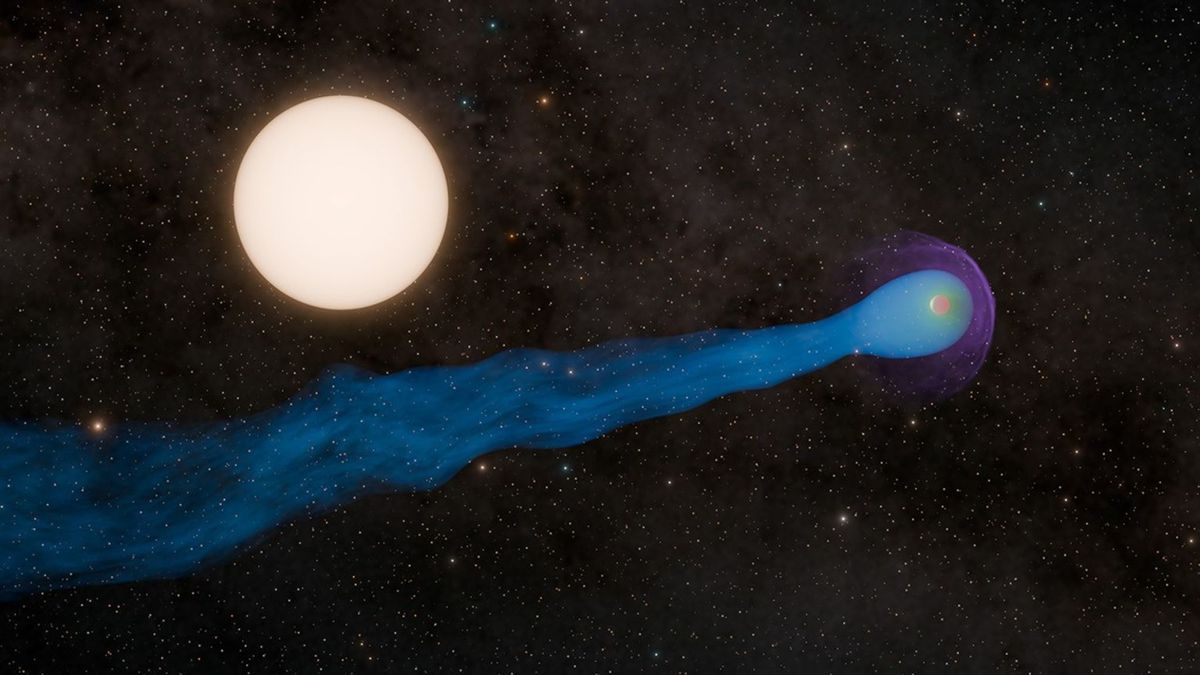A near-Earth alien world has a giant tail trailing behind it that’s longer than 40 Earths and is orbiting close to its home star. Experts say the massive structure, made up of gas leaking from the exoplanet’s atmosphere, is being blown around by stellar winds like a giant “windsock.”
The exoplanet, WASP-69 b, is a gas giant. It’s about the same size as Jupiter but has less than a third the mass, and it orbits a main sequence star about 160 light-years from Earth. It’s so close to its star, the alien completes one revolution around the sun every 3.9 days.
Since its discovery in 2014, researchers have observed that WASP-69 b is losing about 200,000 tons (180,000 metric tons) of mostly helium and some hydrogen gas per second, likely as a result of being superheated by the exoplanet’s star. At this rate, the exoplanet has lost about seven Earth masses during its lifetime, which has lasted about 7 billion years.
Scientists previously speculated that WASP-69 b might have a comet-like tail made of gas leaking into space, but this was never confirmed. However, in a study published Jan.
9 in the journal Astronomy & Astrophysics, researchers used the W.M. The team analyzed the alien world using data from the Keck Observatory and found that it did indeed have a tail that extended over 350,000 miles (560,000 kilometers) — about 44 times longer than the width of Earth. “Previous observations suggested that WASP-69 b had a modest tail, or none at all,” study lead author Dakota Tyler, a doctoral candidate in astrophysics at UCLA, said in a statement released at the time.
“However, we are able to show definitively that this planet’s helium tail extends at least seven times the radius of the giant [exo]planet.” WASP-69 b’s tail is formed when “stellar wind” blows leaking gas away from the exoplanet, leaving a trail behind it. Stellar wind, similar to the sun’s solar wind, is a stream of charged particles that are constantly being thrown out by the star. If the stellar wind disappears, the tail would also fade, the researchers wrote.
“If the stellar wind is reduced, you could imagine the planet still losing some of its atmosphere, but it’s not able to form into a tail shape,” Tyler said in a new NASA statement released Dec. 10. Without the stellar wind, the gas escaping from all sides of the planet would be spherical and symmetrical, he added. “But if you increase the stellar wind, that atmosphere turns into a tail.”
This discovery could help us learn more about how gas giants form and evolve over time, and also provides scientists with a rare opportunity to measure the stellar winds of distant stars using the tail like a giant “windsock,” NASA representatives wrote in the statement.
“These comet-like tails are really valuable because they form when the planet’s escaping atmosphere collides with the stellar wind, blowing the gas back out,” study co-author Eric Petigura, a professor of physics and astronomy at UCLA, said in an earlier statement. “Observing such extended tails allows us to study these interactions in great detail.”



